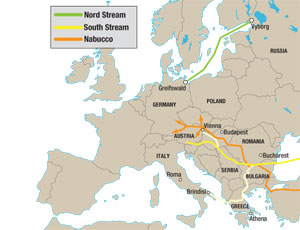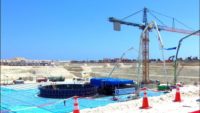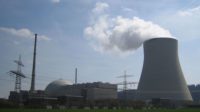Keen to reduce their region’s growing energy reliance on Russia, European financial institutions have thrown their weight behind the $10.3-billion Nabucco gas pipeline through Turkey.

Russia is fighting back with two rival projects, the first already well into construction. Together, the three pipelines could pump 149 billion cu meters of gas per year into the continent.
The 3,300-kilometer-long Nabucco pipeline will cross Turkey, continue through Bulgaria, Romania and Hungary, and terminate some 50 km inside Austria at Baumgarten. It is planned to pick up 31 cu m of gas annually from the Baltic region and Middle East.
The European Bank for Reconstruction and Development (EBRD) and the European Investment Bank (EIB) have just started due diligence on combined project loans of up to $4.2 billion. The World Bank’s International Finance Corp. is preparing to contribute up to $1.1 billion.
The developer, Vienna, Austria-based Nabucco Gas Pipeline International GmbH (NGPI), plans to borrow approximately $7.2 billion and provide the remaining 30% as shareholder equity.
Created six years ago, NGPI is owned equally by large energy companies in Austria, Bulgaria, Germany, Hungary, Romania and Turkey.
“We are absolutely on track. We will start construction in 2011,” says Reinhard Mitschek, NGPI’s managing director. The project is on the “critical path” to completion in 2014, he adds.
NGPI this spring began procuring $4.6-billion worth of long-lead items, including 1.4-m-dia pipes and valves. It also launched environmental impact studies along the route.
Skirting Russia, the Nabucco project is seen as diversifying the sources of Europe’s growing gas demand. Europe must find some 200 billion cu m a year of new gas supplies over the next 15 years, according to forecasts.
“Not having to rely on just a few sources of gas or on pipelines travelling through one geographic area will boost the continent’s energy security,” notes EBRD’s head of energy resources, Riccardo Puliti. “The vast majority” of Europe’s gas imports come from Russia, he adds.
European concerns were heightened last winter when Russia disrupted gas supplies in a dispute with Ukraine, a key supply transit country.
Of the two projects with which Russia is challenging Nabucco, the one that has advanced further—the $9.7-billion Nord Stream project—has placed under the Baltic Sea more than a quarter of the first of two parallel 1,224-km pipelines.
The first, 115-centimeter-dia line is scheduled to start carrying up to 27.5-billion cu m annually, starting next year. The second is planned to follow a year later.
Russia’s state-controlled energy behemoth OAO Gazprom, Moscow, leads the project’s Zug, Switzerland-based joint venture, which includes German and French investors.
Gazprom also leads the development of the more recent South Stream pipeline, which will run from southern Russia 900 km across the Black Sea at depths reaching 2 km. The pipeline will take one of two possible routes though Bulgaria.
The Paris-based giant energy company Electricité de France S.A. recently joined Gazprom and Italy’s Eni S.p.A. to develop South Stream. Designed for 63 billion cu m a year, the project is still in early development.




Post a comment to this article
Report Abusive Comment